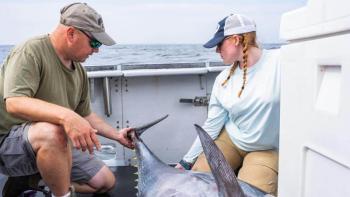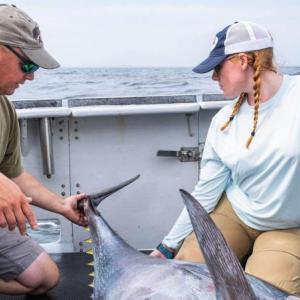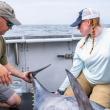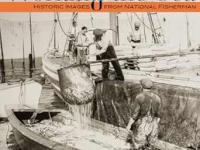Atlantic bluefin tuna diets are shifting in a changing Gulf of Maine, say UMaine researchers
 Walt Golet, (left) and Kay Zipp capture, tag and release Atlantic bluefin tuna in the Gulf of Maine for research in August 2023. Golet co-authored a recent study, led by Sammi Nadeau, that illustrated a shift in the tuna's diet and described the role of foraging in the tuna’s lifecycle. (Photo courtesy University of Maine)
Walt Golet, (left) and Kay Zipp capture, tag and release Atlantic bluefin tuna in the Gulf of Maine for research in August 2023. Golet co-authored a recent study, led by Sammi Nadeau, that illustrated a shift in the tuna's diet and described the role of foraging in the tuna’s lifecycle. (Photo courtesy University of Maine)
 Walt Golet, (left) and Kay Zipp capture, tag and release Atlantic bluefin tuna in the Gulf of Maine for research in August 2023. Golet co-authored a recent study, led by Sammi Nadeau, that illustrated a shift in the tuna's diet and described the role of foraging in the tuna’s lifecycle. (Photo courtesy University of Maine)
Walt Golet, (left) and Kay Zipp capture, tag and release Atlantic bluefin tuna in the Gulf of Maine for research in August 2023. Golet co-authored a recent study, led by Sammi Nadeau, that illustrated a shift in the tuna's diet and described the role of foraging in the tuna’s lifecycle. (Photo courtesy University of Maine)
ORONO — Maine’s coastal communities have been hooked on the Atlantic bluefin tuna since at least the late 1880s — first as bycatch, until the 1930s when the fish became a prized target in fishing tournaments. Through the subsequent decades, bluefin tuna have and continue to support working waterfronts in Maine and beyond. Despite a decline in prices, a single bluefin tuna can land over $10,000, and in 2024 alone, the National Oceanic and Atmospheric Administration reported that commercial and recreational landings exceeded 3.5 million pounds, fueling a range of economic activities from food markets to boat building and gear sales.
Sammi Nadeau ('18, '21G), the lab manager at UMaine’s Pelagic Fisheries Lab, conducted a study recently published in the journal Marine Ecology Progress Series that illustrated a shift in the tuna's diet and described the role of foraging in the tuna’s lifecycle.
“You can imagine that those migrations from across the ocean and things like reproduction are extremely energetically demanding,” said Nadeau, “So being able to get a really good meal, fill back up and get ready to go back across the ocean is important to fulfill their life history.”
Prior studies dating back to the 1980s found that Atlantic bluefin tuna in the Gulf of Maine primarily feed on Atlantic herring. In recent years, though, the Atlantic herring stock in the Gulf of Maine experienced a population decline and hit historic lows. Understanding the role Atlantic herring have historically played in tuna diet, researchers, resource managers and fisheries were prompted to ask how tuna were filling this new gap.
Nadeau and the Pelagic Fisheries Lab, which is led by associate professor Walt Golet in the UMaine School of Marine Sciences, teamed up with partners in fishing tournaments and commercial fishing operations in 2018 and 2019 to secure tuna stomachs, which were later filtered for their contents. The goal was to identify everything in the stomach, determining exactly what species were present. This can be a lengthy process, with researchers identifying what they can visually before sending what cannot be identified off for genetic testing, which can take months.
Researchers observed a large shift in tuna diet away from herring towards menhaden, another fatty pelagic fish sometimes called pogies or bunker. Additionally, they found that Northern shortfin squid were among the primary prey species tuna consumed in 2018 and 2019. While Nadeau and the other researchers expected to find a declined role for herring, they were surprised by how large a role menhaden played, taking over as a primary prey species.
Menhaden already has a commercial role in fish oils. Now as a food source for an important predator, populations will have a larger burden placed on them. Diet and foraging ecology research ensures marine resource managers have the information necessary to create commercial limits and reduce burdens on fish populations when needed. Additionally, this information helps researchers understand Atlantic bluefin tuna as a species that migrates thousands of miles each year, visiting a diverse range of environments.
The study also quantified how energetics, or the energy food sources can provide to the tuna, were affected by these dietary shifts. Once the stomach contents were identified, it was possible to find fish from those species and find out just how energetically rich each prey item was. To conduct this work, researchers use a tool called a bomb calorimeter, which tests a sample by burning it in a sealed container surrounded by water and measuring the change in temperature to see the energy released by the reaction. By and large, researchers believe that menhaden and Atlantic herring share a similar energetic profile, which in addition to the other prey, enables the species to migrate and reproduce.
In addition to Nadeau and Golet, the study was co-authored by Maine Sea Grant Director Gayle Zydlewski and John Carlucci, a quantitative fisheries scientist and member of the Pelagic Fisheries Lab. This work was made possible with help from the Atlantic Bluefin Tuna Association, the Scanlan Family Foundation and the fishermen who have collaborated with the project.
About the University of Maine: As Maine’s only public research university and a Carnegie R1 top-tier research institution, the University of Maine advances learning and discovery through excellence and innovation. Founded in 1865 in Orono, UMaine is the state’s land, sea and space grant university with a regional campus at the University of Maine at Machias. Our students come from all over the world and work with faculty conducting fieldwork around the globe — from the North Atlantic to the Antarctic. Located on Marsh Island in the homeland of the Penobscot Nation with UMaine Machias located in the homeland of the Passamaquoddy Nation, UMaine’s statewide mission is to foster an environment that creates tomorrow’s leaders. As the state’s flagship institution, UMaine offers nearly 200 degree programs through which students can earn bachelor’s, master’s, professional master’s and doctoral degrees as well as graduate certificates. For more information about UMaine and UMaine Machias, visit umaine.edu/about/quick-facts/ and machias.edu/about-umm/umm-facts/.



























